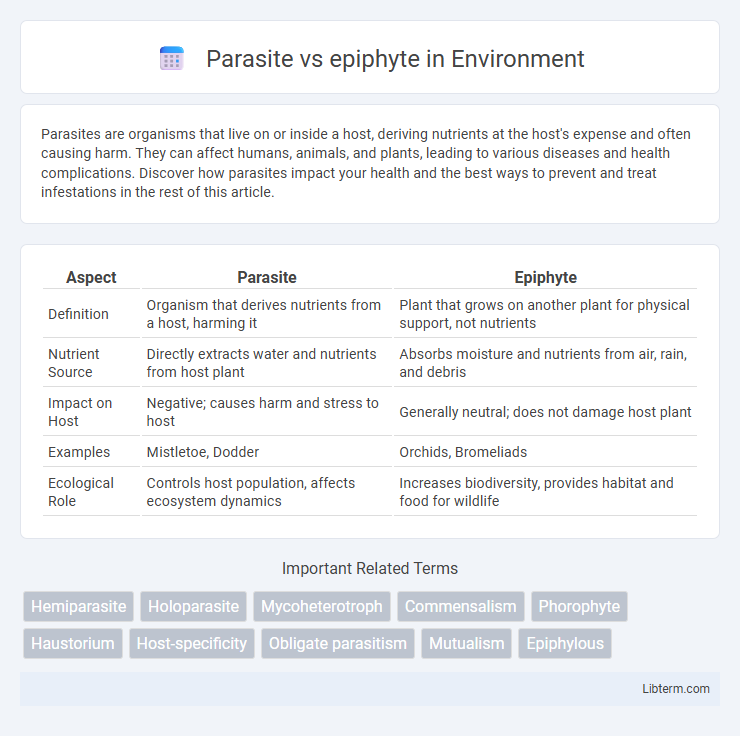Parasites are organisms that live on or inside a host, deriving nutrients at the host's expense and often causing harm. They can affect humans, animals, and plants, leading to various diseases and health complications. Discover how parasites impact your health and the best ways to prevent and treat infestations in the rest of this article.
Table of Comparison
| Aspect | Parasite | Epiphyte |
|---|---|---|
| Definition | Organism that derives nutrients from a host, harming it | Plant that grows on another plant for physical support, not nutrients |
| Nutrient Source | Directly extracts water and nutrients from host plant | Absorbs moisture and nutrients from air, rain, and debris |
| Impact on Host | Negative; causes harm and stress to host | Generally neutral; does not damage host plant |
| Examples | Mistletoe, Dodder | Orchids, Bromeliads |
| Ecological Role | Controls host population, affects ecosystem dynamics | Increases biodiversity, provides habitat and food for wildlife |
Introduction to Parasites and Epiphytes
Parasites extract water and nutrients directly from their host plants, often causing harm, while epiphytes grow on other plants for physical support without taking nutrients from them. Parasites typically possess specialized structures like haustoria to penetrate host tissues, whereas epiphytes rely on air, rain, and debris for sustenance. Understanding these fundamental differences highlights their distinct ecological roles and adaptations within plant communities.
Defining Parasites: Characteristics and Examples
Parasites are organisms that derive nutrients and sustenance from a host organism, often causing harm in the process. They typically have specialized structures like haustoria to penetrate the host's tissues and extract water and nutrients. Common examples include mistletoe, which attaches to tree branches, and dodder, a vine that wraps around other plants to access their resources.
What are Epiphytes? Key Features and Types
Epiphytes are plants that grow non-parasitically on other plants or objects, deriving moisture and nutrients from the air, rain, and debris accumulating around them. Key features include their adaptation to obtain water through specialized roots or leaves, absence of direct harm to host plants, and their common presence in tropical rainforests where they maximize light exposure. Major types of epiphytes include orchids, bromeliads, ferns, and mosses, each exhibiting unique mechanisms for nutrient absorption and water retention.
Life Strategies: How Parasites and Epiphytes Differ
Parasites rely on host plants by extracting water, nutrients, and sometimes carbohydrates, often harming the host's growth and health, while epiphytes obtain moisture and nutrients primarily from the air, rain, and debris without directly damaging the host plant. Parasites possess specialized structures like haustoria to penetrate host tissues, whereas epiphytes use aerial roots or specialized scales to anchor themselves and absorb resources independently. This fundamental difference in life strategies highlights parasites as dependent organisms that exploit hosts, contrasting with epiphytes' non-parasitic, commensal approach to survival in their environment.
Nutrient Acquisition: Host Dependency vs Independence
Parasites obtain nutrients directly from their host plants by penetrating their tissues and extracting water and essential minerals, causing harm to the host's health and growth. Epiphytes, in contrast, acquire nutrients independently by absorbing moisture and minerals from the air, rain, and debris around them without relying on a host plant. This fundamental difference in nutrient acquisition highlights the parasitic dependence on host vascular systems versus the epiphytic adaptation to nutrient availability in their aerial environment.
Ecological Roles in Their Environments
Parasites extract water and nutrients directly from their host plants, often causing harm by weakening or stunting their growth, thus playing a role in controlling host population dynamics and influencing community structure. Epiphytes, on the other hand, grow non-parasitically on other plants to access sunlight and air, contributing to biodiversity by providing habitats and enhancing nutrient cycles without damaging their hosts. Both organisms support ecosystem complexity, with parasites affecting species interactions and epiphytes influencing microhabitats and resource availability in forest canopies.
Impact on Host Plants and Surrounding Ecosystems
Parasites extract water and nutrients directly from host plants, often causing weakened growth, reduced reproductive capacity, and increased susceptibility to diseases, which can lead to population declines in affected plant species. Epiphytes, while they rely on host plants for physical support, do not siphon nutrients, typically causing minimal harm and sometimes enhancing habitat complexity by providing microhabitats for various organisms. The presence of parasites can disrupt ecosystem stability and biodiversity by altering plant community dynamics, whereas epiphytes contribute positively to ecosystem diversity without significantly impacting host plant health.
Adaptations for Survival: Parasites vs Epiphytes
Parasites have evolved specialized structures like haustoria to penetrate host tissues and extract water and nutrients, enabling survival without photosynthesis. Epiphytes develop adaptations such as thickened leaves for water storage, trichomes for capturing moisture from the air, and extensive root systems for anchorage and nutrient absorption from debris. These contrasting strategies illustrate how parasites depend on host plants for sustenance, while epiphytes optimize resource acquisition from the environment to thrive independently.
Human Uses and Cultural Significance
Parasitic plants like mistletoe have cultural significance in European traditions, symbolizing fertility and protection, while epiphytes such as orchids hold economic value in horticulture and traditional medicine worldwide. Epiphytes are used decoratively and medicinally in many cultures, contributing to biodiversity and cultural heritage, whereas parasitic plants are often studied for their unique adaptations and ecological impacts. Both parasitic and epiphytic plants influence human culture through their roles in folklore, art, and ecosystems supporting biodiversity.
Conclusion: Key Differences and Importance
Parasites extract nutrients directly from host plants, often causing harm, while epiphytes derive moisture and nutrients from the air and debris without damaging their hosts. This distinction highlights the ecological roles parasites play in plant population control versus the mutualistic benefits contributed by epiphytes to biodiversity. Understanding these differences is crucial for managing ecosystems, conserving plant species, and maintaining habitat health.
Parasite Infographic

 libterm.com
libterm.com